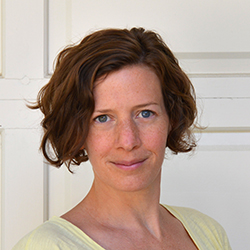What do cow tunnels, an ice cream orchestra and the Chinese cryosphere all have in common?
They’re all covered on Edible Geography, our blog crush of the month. Nicola Twilley is the mastermind behind the site that combines design, science, history and food in surprising and wonderful ways.
Even though she’s now a co-host of the food podcast Gastropod and a regular contributor at the New Yorker, Nicola never aspired to journalism. Growing up in England, that career path never appealed to her — she was a self-described “shy kid who liked writing but not interacting,” and the idea of making phone calls and knocking on doors all day was a turnoff. She didn’t see many opportunities for the type of long form non-fiction writing that interested her, so she moved to the U.S., got a masters degree in Art History and started working in non-profits.
The blog was born at a time when she was becoming increasingly dissatisfied with her career. Her husband was running BLDGBLOG and having a lot of fun with it, and she realized she wanted to start her own writing project. She laughs when she thinks back on it. “There was no plan… but there was this kind of blind hope, like, maybe I’ll give up after a month. But I really loved it for the start. I’m such a junkie for the written word. I had this abstract teenage fantasy of becoming a writer.”
So how did food become her primary focus? According to Nicola, everything came together when she saw Caroline Steel speak about her book Hungry City. She was blown away by the way Steel wrote and spoke about the way food shaped London and London shaped food, and she realized she could use food as a lens and a theme to write about pretty much anything. She calls food “inherently attractive” — writing about food paves the way for talking about concepts that can seem dry or archaic when presented under different circumstances.
Even though the blog is five years old, she already felt like she was behind the curve when she started. At the time, she was “blissfully ignorant about food” — she had never read Michael Pollan, and she had no idea that the food movement was about to take off. “At first, I was kind of embarrassed that it sounded so girly… I had a weird sense that I was doing something that was not serious and was split along gender lines.”
Most of her inspiration comes from reading books. “I have a weird feeling that you shouldn’t just aggregate things on the internet… books are the undervalued engine of blogging” she says, and she tries not to write about topics that have already been covered online more than once. One of my favorite posts, which was later turned into an episode of 99% Invisible, came from half of a sentence in a book about steak. The author made a tangential mention of unconfirmed cow tunnels under New York City and Nicola was captivated.
She’s a voracious blog reader as well; when I asked her to name a few of her favorites, she rattled off a list that lasted longer than it will you to read this article. A few of her staples include Civil Eats, Marion Nestle’s food politics blog, the Agricultural Biodiversity Weblog, Air Cargo News, Archaeology Magazine and various smell blogs — “that’s a weird sub-community!”
Although she’s busy with the podcast, the New Yorker and a forthcoming book about refrigeration (she recently interviewed a woman who spent her twenties living in a refrigerated shipping container), she’s still finding time to post on Edible Geography, and she’s even planning a redesign this year.
New to her website? For starters, we suggest checking out these five posts:
- Ten Landmarks of the Chinese Cryosphere
Twilley compiled a list of ten stand-out destinations for the armchair Chinese cryotourist, based on her own travels while reporting this story on refrigeration for The New York Times Magazine. - How Wine Became Metropolitan: an Interview with David Gissen
Twilley caught up with David to talk about what this shift in cartographic aesthetic can reveal about the geography of wine. Their conversation ranges from the dominance of Riedel glasses, the use of concrete in wine-making and the best subway stop from which to embark on your own journey of wine exploration. - Harvesting Winter
There are only a handful of places left in the United States that still practice the forgotten art of harvesting winter. Twilley visited South Bristol, Maine, to take part in the annual ice cutting at the Thompson Ice House, a small wooden shack by the side of State Route 129 that claims to be “the only commercial ice house on the National Register of Historic Places to have stored naturally frozen ice harvested in the traditional way from a nearby pond.” - Spice Tile
Laurent Mareschal’s “Beiti” is a carpet made of spice, carefully sieved through stencils into tiled patterns inspired by Arabic geometry. Twilley saw it London’s Victoria & Albert Museum, on display as part of the Jameel Prize shortlist of Islamic-influenced contemporary art, craft and design. - Cow Tunnel Quest Update
Twilley continues her search for the the semi-mythical cow tunnel or cow tunnels: a subterranean part of Manhattan’s lost meat infrastructure, built to ease urban cow-jams at a particular historical moment — a time when live cattle were being brought to the city for slaughter in increasing quantities thanks to both its expanding population and the invention of the railway, but before the widespread adoption of cheap, reliable refrigeration meant that dead beef could travel long distances, meaning that abattoirs could be re-located outside densely populated areas.
Looking for more food blogs to follow? Check out this roundup from our editors.



